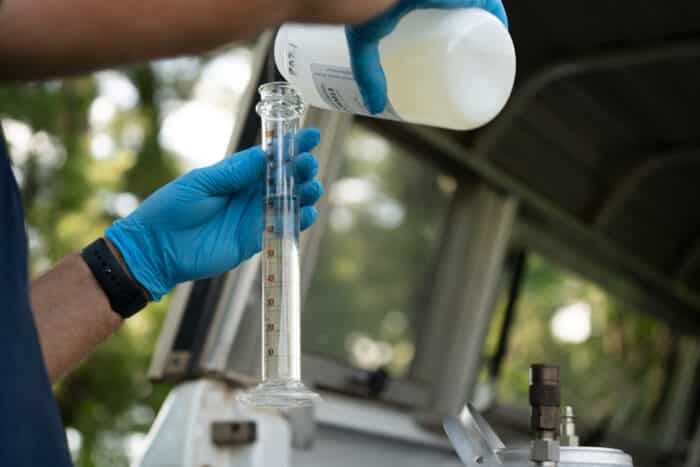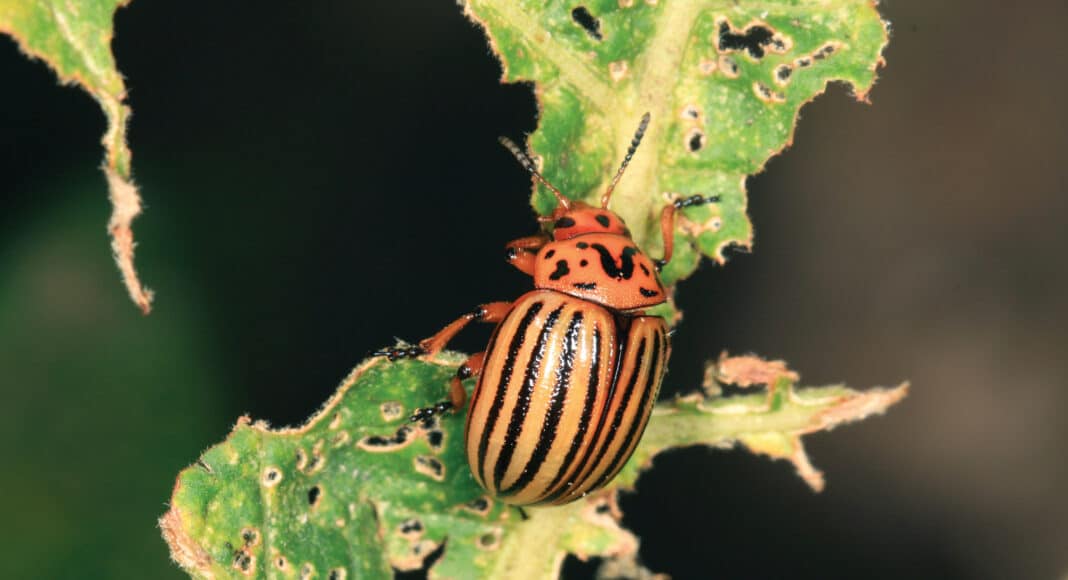The first sprayable insecticide based on dsRNA technology has been approved in the U.S. and could be coming soon to Canada.
A new weapon could soon be available to assist battle-weary potato farmers in Canada in their relentless war against the Colorado potato beetle (CPB).
It’s called Calantha, a foliar applied, contact biopesticide that utilizes a ribonucleic acid (RNA) technology that has just been approved by the U.S. Environmental Protection Agency (EPA) south of the border.
The product’s maker, GreenLight Biosciences based in Medford, Massachusetts, is also seeking regulatory approval for Calantha in Canada and hopes to introduce it to potato producers here in the not-too-distant future.
In approving the biopesticide for CPB control in potatoes in January, the EPA described Calantha as the world’s first sprayable double-stranded RNA (dsRNA) pesticide allowed for commercial use on crops.
In a press release, GreenLight Biosciences CEO Andrey Zarur called the registration of Calantha “not just a milestone for our company, but a quantum leap for farmers, our food system and security, and people.”
Calantha uses RNA interference as its mode of action against Colorado potato beetles. Its
unique active ingredient, called ledprona, is so new that a brand-new insecticide category, Group 37, was created for it in 2023 by the the Insecticide Resistance Action Committee, a global public-private technical advisory group focused on resistance management.
GreenLight Bio has numerous other RNA-based products in the pipeline, including one that protects honeybees from the Varroa destructive mite, the nemesis of beekeepers worldwide.
Mark Singleton, chief commercial officer and general manager of plant health at GreenLight Biosciences, discussed Calantha in an interview with Spud Smart.
He talked about how Calantha will be first to market in the dsRNA biopesticides space this year, with several states already approving it for use in potatoes. In addition to the U.S. and Canada, GreenLight Bio plans to introduce the biopesticide to the European Union and also Ukraine, and has submitted it for regulatory approval in those jurisdictions.
The way the technology works is that the dsRNA in Calantha is consumed by the beetles feeding on potato plants. It then acts to silence the gene in the insect that enables it to safely eat the potato leaves (which are toxic to humans and numerous animals). Eventually, the beetle stops feeding and dies from the toxins in the food it has consumed.

“The thing about Colorado potato beetle is it eats a lot, so it ingests a lot of dsRNA very quickly and it does its job,” said Singleton.
He noted GreenLight Biosciences first started work on developing the biopesticide six years ago and has tested Calantha extensively in field trials in the United States as well as Canada.
“The product has been tested in Canada, so we have data under Canadian conditions,” he said.
Calantha’s novel dsRNA-based formula was designed to specifically target Colorado potato beetles and nothing else. For this reason, GreenLight Bio maintains the product won’t harm beneficial insects like ladybugs and honeybees or other non-target insects or mammals.
The company’s trials indicated Calantha had no effect on any species tested except for CPB, even when tested at 100 times the rate that it will be applied at in agricultural fields.
Calantha was also shown to break down quickly in the soil, degrading within three days and leaving no detectable harmful residue on plants or in the environment, soil or waterways.
According to Singleton, Calantha will be priced competitively with other CPB control products.
“One of the big issues that the industry faced going through with RNA development is it was not cheap to make. As time has progressed, it’s become cheaper and cheaper for us to produce it. We are now at below a dollar a gram,” he said. “This allows us to be cost competitive with the best products that are on the market.”
Singleton said Calantha will have a similar price, performance and application timings and will use the same application equipment as the leading crop protection brands used to manage CPB.
The biopesticide has certainly caught the attention of the potato industry. In October 2023, prior to Calantha’s registration, the National Potato Council (NPC) in the U.S. sent a letter of support for it to the EPA.

The NPC described Calantha as “an effective tool for potato producers across the United States struggling to protect their crops from the damaging Colorado potato beetle.
“This new and innovative pest control technology will allow growers for the first time to treat for Colorado potato beetle in a highly selective way that respects beneficial species and the health of farm workers,” the NPC wrote.
Cam Donly is a research scientist who specializes in biopesticide development and insect resistance management as part of his work at Agriculture and Agri-Food Canada in London, Ont.
In an interview with Spud Smart, Donly said he believes dsRNA pesticides have great potential and are going to be important for farmers in the future.
“The mechanism of action for dsRNA insecticides is completely new, so that means they can be useful in addressing issues with resistance,” he said.
“It doesn’t really lead to a buildup in the environment because it’s a biological product, and it tends to be degraded quite efficiently by natural systems,” Donly added. “This makes it a lot easier to integrate it into an IPM system.
He cautions that excitement over a new mechanism of insecticide does not mean the product is perfect.
“(Biopesticides) are relatively slow compared to synthetics … and research so far has indicated that resistance is possible, so implementation of it does need to be managed quite conservatively,” he said.
Donly maintained the use of all novel mechanisms for pest control “should always be accompanied with very defined and specific strategies to mitigate resistance development.”

Vikram Bisht, a plant pathologist and potato specialist with Manitoba Agriculture, told Spud Smart he believes a product like Calantha offers a lot of promise for Canadian potato producers because of its new, novel mode of action.
“Molecular biology is coming into the forefront,” he said. “It is going to be a very valuable tool if it is introduced.”
“We have insecticide resistant populations (of CPB) all across the county, and they have varying level of resistance to the insecticides. In some places, newer products have been tried and they are not working very well. If we are able to rotate the chemistries, in this case a mode of action that is different, it will reduce the population of those potentially resistant populations,” Bisht added.
“For example, if you put on an insecticide first as a seed treatment, then whatever comes back to infest the potato crop afterwards can be taken care of with RNA technology like Calantha. You will have multiple attacks on the insect, so the chances of resistance development are minimized.”
Bisht, however, cautioned against viewing RNA-based pesticides as some kind of a silver bullet.
“Colorado potato beetles have been extremely adaptable to newer chemistries. It is one of the most challenging insects to develop a product for,” he said. “Even though this is a new tool, scientists need to be prepared for the development of resistance against this.”
Bisht said one thing he’d really like to see is an RNA-based spray that tackles more than one pest problem.
As Singleton pointed out, solutions like this are already in the works at GreenLight Biosciences. The company plans to submit one product for EPA regulatory approval that targets Botrytis cineriea and other common fungal pathogens at the same time, and the GreenLight Bio pipeline includes other multi-target biopesticides as well.











